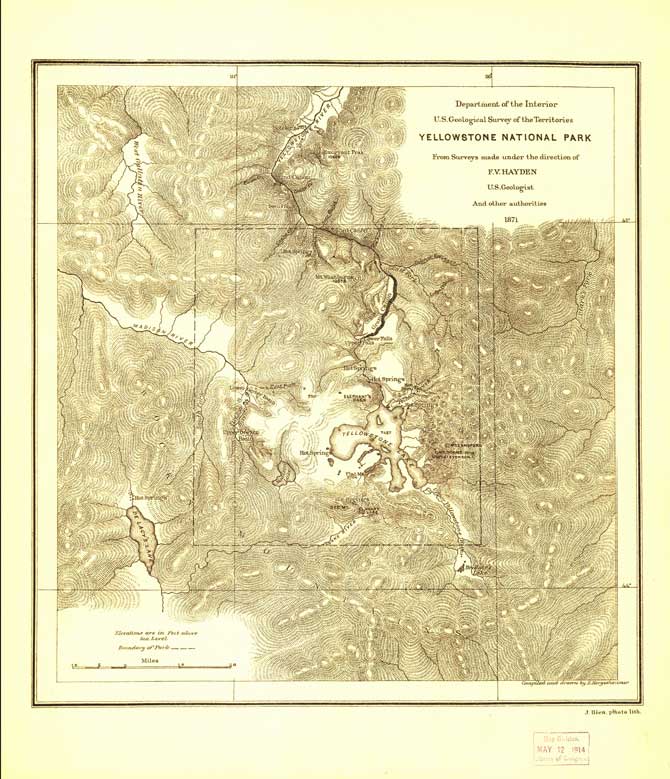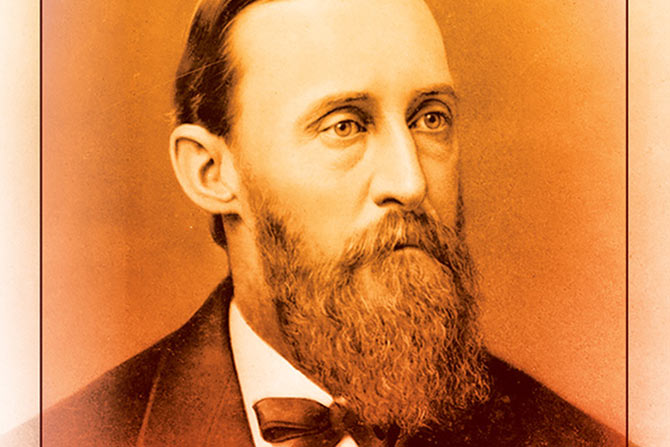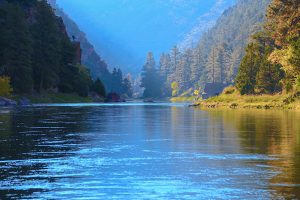Jim Greer grew up in Wyoming. His father was a land surveyor for many decades as well as a U.S.G.S. cartographer and professional geologist. Jim spent every summer from age nine through college out in the wilds of rural Wyoming performing surveys, mining claims, water rights and power line easements with his father “carrying the dumb end of the chain,” as he fondly recounts.
Jim is also a history buff, and in 2021, when he moved to Ogden, Utah, with his family, he decided to start learning about the history of the area. “Ogden has a very interesting and colorful history,” he mused. The city was the first permanent settlement in Utah — established in the 1840s by the trapper Miles Goodyear and originally named Fort Buenaventura. The first transcontinental railroad was joined in 1869, and Ogden Station became a main railroad junction because of its location along major east-west and north-south routes.
In his research, Jim came across a link to dozens of historical photos of the Ogden area. “It was so interesting to learn more about the history, and then all of a sudden, I came to one of these historic photos of the 1871 Hayden survey party camp.” Jim quickly recognized, based on the proximity to Ogden Peak, the location of the first camp of Ferdinand Hayden’s survey in the photo. “It caught my attention immediately as the son of a surveyor. I knew about the great surveys of the American West during the 1860s and 70s, but I didn’t know that one of the premier ones, the Hayden survey started right here in Ogden. I looked at that photo, and I thought, well, that’s pretty close to my house,” Jim said.
Realizing the significance of the photo and now knowing the location of the camp, Jim decided to reach out to a cross-section of local surveyors via email and pitched the idea of commemorating Ferdinand Hayden’s Great Survey of the West (of Yellowstone area) that originated in Ogden, Utah in 1871.
The email read in part, “One of the Great Surveys of the American West originated in Ogden 150 years ago this year. It all started right here, a short walk from my home. The 1871 Hayden survey party left Ogden on June 8, 1871, and completed their famous Yellowstone mapping expedition at Fort Bridger on Oct. 2, 1871. The improved Yellowstone mapping and great public interest sparked from their survey along with several other expeditions a few years earlier contributed immensely to the U.S. Congress declaring Yellowstone a national park in 1872.”
The email generated a number of responses from interested parties and an invitation to speak at the 2023 UCLS Annual Conference in St. George. Jim filled the historical slot and spoke about Hayden’s survey and the ties to Ogden.
The Hayden Geological Survey of 1871 explored northwestern Wyoming and the surrounding region. This was not Hayden’s first survey, but it was the first federally funded geological survey to explore and further document the area that is known today as Yellowstone National Park. Hayden played a prominent role in convincing the U.S. Congress to pass the legislation creating the park.
This was a big deal at the time. The western territory was largely unmapped, and along with Hayden, three other explorers — Clarence King, George Wheeler, and John Wesley Powell — were individually tasked with mapping different sections of the western frontier.



To understand the importance of this event and the conditions under which Hayden was to do his fieldwork in 1871, a letter of instruction was penned from the Secretary of the Interior, which reads in part:
In accordance with the act of the third session of the 41st Congress, making appropriations for the continuation of the Geological Survey of the Territories of the United States, dated March 4, 1871, you are appointed U.S. Geologist, to date from the first day of July, 1871, with a salary of four thousand dollars per annum [an increase of $1,000]. You will be permitted to select your own assistants, who will be entirely subject to your orders, and all your expenditures of the public funds are expected to be made with judicious economy and care.
The area of your explorations must be, to some extent, discretionary, but in order that you may continue your labors of preceding years, geographically, your explorations of the present season will be confined mostly to the Territories of Idaho and Montana. It is probable that your most available point of departure will be Salt Lake City, proceeding thence northward along the mail route as a base to Helena, Montana, and completing the season’s work about the sources of the Missouri and Yellow Stone rivers. You will be required to make such instrumental observations, astronomical and barometrical, as are necessary for the construction of an accurate geographical map of the district explored, upon which the different geological formations may be represented with suitable colors.
As the object of the expedition is to secure as much information as possible, both scientific and practical, you will give your attention to the geological, mineralogical, zoological, botanical, and agricultural resources of the country. You will collect as ample material as possible for the illustration of your final reports, such as sketches, sections, photographs, etc.
Should your route lead you in the vicinity of any of our Indian tribes, you will secure such information in regard to them as will be useful to this Department, or the Country. It is desirable that your collections in all Departments shall be as complete as possible, and you will forward them to the Smithsonian Institution to be arranged according to law.
You will be expected to prepare a preliminary report of your labors, which will be ready for publication by Jan’y 1, 1872.
Hayden hired and assembled a large team that included topographers, zoologists, botanists, meteorologists and artists, amongst others. Of note, the famous photographer William Henry Jackson, who was originally commissioned by the Union Pacific to capture and document the scenery along various railroad routes, was invited to join the government survey of the Rocky Mountains led by Hayden. He captured the first known photographs of Yellowstone. And Thomas Moran, whose landscape paintings from the expedition still hang in the Smithsonian American Art Museum in Washington, D.C.
An excerpt from Moran’s diary describes the awe and beauty that met the surveying party:
“… of the route lay through a magnificent forest of pines & firs all growing straight as a ships mast, & growing but a few feet apart, passed over the debris of a great land slide where the whole face of the Mountain had fallen down at some time, laying bare a great cliff some 500 feet high. The view of the lake, as we approached it, was very beautiful. It is a small pool formed by the widening of stream at this point, it is not more than half a mile in any direction. The Mountains surrounding it are about 11,000 feet high & about 3000 ft. above the level of the lake having snow still upon them. …”
The mountains and lakes, rivers and canyons, rock formations and geysers were unlike anything anyone had seen before, and it captured the imagination of our nation. In 1871, the New York Times wrote, “There is something romantic in the thought that, in spite of the restless activity of our people, and the almost fabulous rapidity of their increase, vast tracts of the national domain yet remain unexplored. As little is known of these regions as of the topography of the sources of the Nile or the interior of Australia. They are enveloped in a certain mystery, and their attractions to the adventurous are constantly enhanced by remarkable discoveries. … Sometimes, as in the case of the Yellowstone Valley, the natural phenomena are so unusual, so startlingly different from any known elsewhere, that the interest and curiosity excited are not less universal and decided.”
On March 1, 1872, the 42nd Congress of the United States signed a law titled, An Act to set apart a certain Tract of Land lying near the Headwaters of the Yellowstone River as a public Park. This landmark legislation created the first national park.
The Hayden survey party enjoyed the work so much that in 1872, they returned to the same base camp in Ogden, Utah, to continue their work of exploring the western U.S. throughout the 1870s.
Based on Jim’s research along with others, we know that today, Hayden’s base camp is located near the Ogden High School, around 28th Street and Polk Ave. Jim has proposed that the beginning of this historical event be tied to the end — by erecting a plaque on location in Ogden to commemorate the First Camp of the survey, which inspired a nation and resulted in one of America’s best ideas — our public National Park System. This will, in Jim’s words, “Celebrate America’s wonderful heritage and freedoms and inspire a new generation of young surveyors, our nation’s future measurers and leaders and the upcoming all-stars.”
To get involved and learn more about helping this landmark become a reality, please reach out to Bahram Rahimzadegan, Golden Spike Chapter President at https://tinyurl.com/GoldenSpikeChapter.


About Jim
Jim Greer has an Engineering degree from the University of Colorado and received an MBA from the University of Utah. He has also attended MIT and Stanford University. He is a U.S. Air Force Veteran and currently works in the energy industry. He is the project director of the Advanced Clean Energy Storage Hub, constructing the world’s largest renewable hydrogen production and storage facility, located in Delta, Utah.







